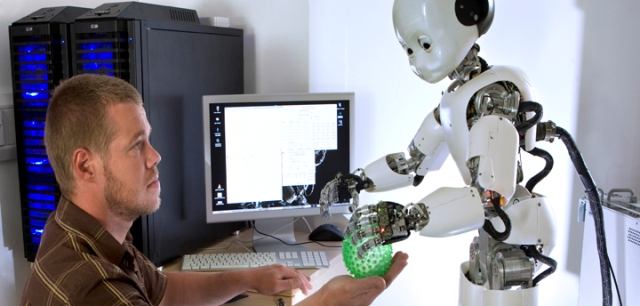Feb 1 2016
A major new €3.5million research initiative led by the University of East Anglia will aim to improve understanding of a fundamental part of communication in humans.

Over four years, 13 different projects will explore deictic communication, which forms the crucial connection between language and objects and locations in the world. It allows speakers to direct attention to particular parts of the spatial world, for example ‘this mobile phone’ or ‘that set of keys’.
Deictic communication is critical to understanding human to human interaction, and human to system interaction in a range of technology applications – from mobile phones to intelligent robots – and to the enhancement of clinical and educational interventions, for example for stroke patients and those with Autism Spectrum Disorder.
The programme, called DComm, will see UEA work with 11 European partner organisations, including Plymouth University in the UK, the Norwegian University of Science and Technology (NTNU), and industry experts such as motion capture specialists Qualisys, based in Sweden, and automation company Telerobotlabs, in Italy. Support will also come from organisations specializing in software and technology development, architecture and brain rehabilitation.
Funding comes from the European Union via Marie Sklodowska-Curie actions (MSCA), which supports research training and career development. As a European Training Network, the programme will train the next generation of scientists in methods necessary to make significant progress in understanding deictic communication. The research and training will be structured around two themes – understanding deictic communication and deictic communication in application.
Prof Kenny Coventry, head of the School of Psychology at UEA and DComm coordinator, said: "Communication involves a combination of language and gestures that act together. Deictic communication is critical to understanding not only how communication develops typically in a range of spoken and signed languages, but also when communication can potentially break down in a range of clinical and atypically developing populations, from stroke patients to those with Autism Spectrum Disorder.
"Understanding deictic communication is also essential to develop robots with better communication skills, and to understand how people can most effectively interact when communicating with each other about the spatial world, for example, in architectural design or through mobile phones and other technology applications. DComm will train researchers in both the basic science of deictic communication and in application, with a broad range of potential beneficiaries in both the private and public sectors.”
Prof Coventry added: "UEA is delighted to be leading this interdisciplinary training network that brings together an exciting mix of leading scientists and industrial partners to understand deictic communication both conceptually and in application."
Two of the 13 projects are being led by UEA. One will explore deictic communication in development and how children learn to direct attention using language and gesture. The other will investigate deictic communication in stroke patients with visual neglect, the most severe and common visual processing problem observed after stroke. Visual neglect is characterised by a loss of awareness of the side of space opposite to the side of the stroke. Although patients are not blind to that side of space, they do not perceive or attend to it.
Other projects will focus on: deictic language and gestures in developmental deficits; deictic communication in sign languages; applications in robot language learning; deictic communication and mobile phones; improved motion capture methodology and tools in linguistic research; iCub robot hand redesign for gestural and deictic interaction; and deictic communication in architectural and urban design.
DComm starts this month with the recruitment of early stage researchers for the 13 projects. The project has received funding from the European Union’s Horizon 2020 research and innovation programme under the Marie Sklodowska-Curie grant agreement No 676063.